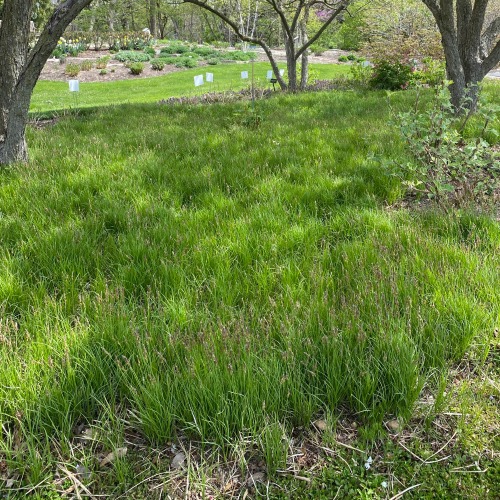Sedges for the Landscape
Sedges have edges, rushes are round, grasses have nodes from their tips to the ground by Heather Prince
The Landscape Contractor, May 2023
Sedges seem to be creeping into our landscape palettes, designs, and gardens as we discover their versatility and utility as ground-covering plants. Mt. Cuba Center in Hockessin, Delaware recently released their Carex for the Mid-Atlantic Region research report. This in-depth report summarizes the findings of their Carex trial where they grew 65 species and 5 cultivars of sedges in both sun and shade to test their adaptability. The reports from Mt. Cuba, like the Chicago Botanic Garden Plant Evaluation Program, provide the green industry and homeowners with science-based rigorously tested results so that we can make good choices for our designs and gardens. You may have seen more and more Carex, especially native species, become demanded by municipalities, commercial sites, and residential projects as the naturalistic design trend becomes more rooted in our horticulture vocabulary. There is a sedge for almost any situation that will cover the ground, hold soil, and provide a beautiful grassy texture. From clients seeking a meadow-like approach to those restoring woodlands and wetlands, sedges can add lovely textural grace notes and help create a sense of Midwestern place.

Finding a place for your sedge desire
Sedges blend easily with both native and ornamental plantings, often slowly forming colonies and providing the base layer of a planting. As cool season plants, they green up early in the spring, sometimes blooming before their full growth is achieved. You’ll find all sorts of delicate flower habits from nodding clustered strands to fuzzy blonde blossoms to tiny starry flowers tossed like fairy confetti. Their dried seedheads may also be interesting and ornamental. Most of our sedges have degrees of fine narrow foliage that gently drapes as a tufted mound, although some are denser or have wider blades. Sedges should be left to dry over the winter as they provide important leaf litter for overwintering insects. They can be a nice ‘soft landing’ under trees to encourage our many species of pupating butterflies and moths that require shelter during the winter before emerging in spring. Sedges are also larval hosts to several species of butterflies and moths, while birds enjoy the seeds. You may give Carex a light string trim in late winter, but if the design allows, leave the blades as mulch. Songbirds will pick dried foliage for nesting materials, increasing the ecological functions of your planting.


